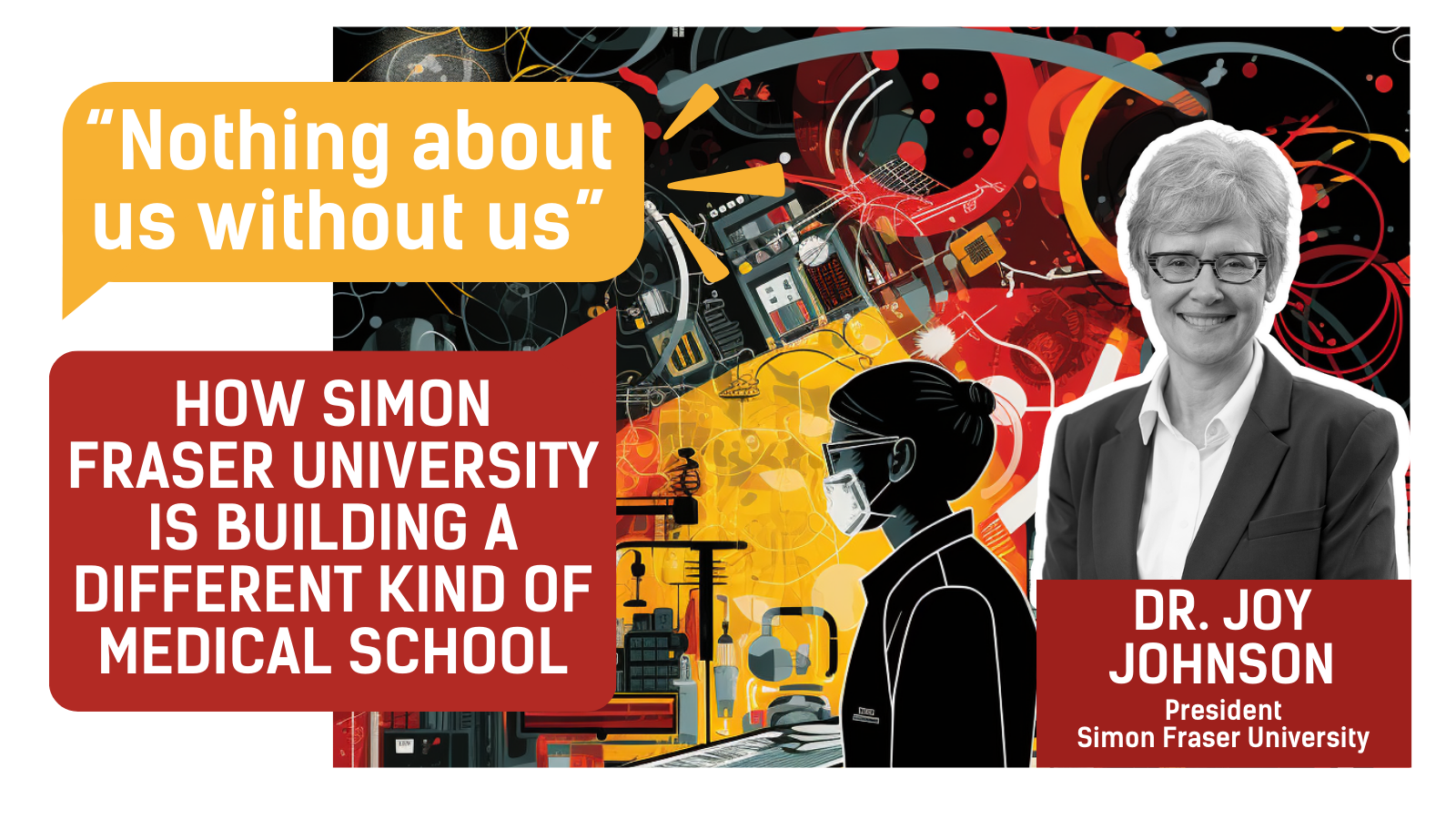“Nothing about us without us”: How Simon Fraser University is Building a Different Kind of Medical School

Author(s):
Dr. Joy Johnson
Simon Fraser University
President
Disclaimer: The French version of this editorial has been auto-translated and has not been approved by the author.
Before I became president and vice-chancellor of Simon Fraser University (SFU), I was a healthcare researcher. And before that—inspired by my mother’s career choice—I was a nurse.
In both roles, I developed a deep and abiding appreciation for the value of public health care in Canada.
As a nurse, I saw the way that access to high-quality health care could completely change the course of someone’s life. At the same time, I started my career in the midst of the AIDS crisis and saw the opposite—how the healthcare system could hurt and exclude many marginalized and vulnerable people.
As a health researcher, I watched those same patterns play out. Inclusive and thoughtful health research can significantly improve people’s quality of life. When done poorly, it can hurt more than it helps.
Much has changed in our healthcare system since then. What hasn’t changed is the central role health care plays as a measure of the obligations we owe to one another and as a barometer of our society’s overall well-being and inclusiveness.
For this reason, like Canadians everywhere, I am deeply concerned about the significant challenges facing our healthcare system—from the severe doctors shortage and the opioid crisis to the weaknesses exposed in our system by COVID-19—and what they mean for the future of our country.
So, when the Province of British Columbia asked Simon Fraser University to establish the first new medical school in Western Canada in 55 years on our Surrey campus, I knew both the weight of that commitment and the exciting opportunity that came with it.
For the SFU Medical School to be successful and live up to the promise of public health care, not only will it have to educate the new doctors we so badly need, but it will also have to help transform the way in which health care is delivered, particularly to those in marginalized and underserved communities.
In this regard, SFU’s university-wide commitment to uphold Truth and Reconciliation is of particular significance to the medical school’s future —a future that must reflect the lived experiences and voices of Indigenous people who have been victimized by racism within the health care system.
This history is well documented and continues to the present day.
In 1941, B.C.’s first “Indian hospital” was established in response to fears of tuberculosis infection. Inside these sanitoriums, Indigenous patients were subjected to unsafe conditions and forced physical restraint, often tended to by undertrained and unlicensed staff. This past September, the Stó:lō Nation in B.C.’s Fraser Valley identified 96 Indigenous children between the ages of five and 20 who died at the Coqualeetza Indian Hospital.
More than eighty years later, all indications from reports, work, and research in this space indicate that systemic racism and discrimination continue to persist in healthcare settings.
If SFU’s commitment to Truth and Reconciliation is to mean anything, then we have a responsibility to ensure that the new medical school confronts the colonial history of medical education by integrating reconciliation, anti-racism, and Indigenous health and wellness into the medical curriculum.
The Truth and Reconciliation Commission’s Calls to Action contain specific recommendations around health care and have been instrumental during the planning process. We are also taking the lead from Indigenous students, staff, and faculty, who have been clear that the “nothing about us without us” principle must be threaded into the school’s DNA.
To that end, SFU is committed to working with Indigenous communities to ensure that the medical school reflects their feedback and that graduate physicians are prepared to respond to community needs.
In these early days of planning, we have spent a lot of time in meetings and discussions with Indigenous groups, including the First Nations Health Authority, whose partnership will be vital to this work. We have held several consultation sessions with Indigenous students, faculty, and staff at SFU and initiated discussions with Host First Nations and other groups to seek feedback on how the medical school can and should benefit them. Based on these conversations, we are making it a priority to hire Indigenous leaders, physicians, and staff for the school. As the planning process continues, we are also thinking about how we can create pathways for Indigenous students to study medicine and create opportunities for students to learn directly from Indigenous Elders and Knowledge Keepers during their medical training.
This is hard work. But it is important and necessary work that we are proud to have been entrusted with.
Although it has been many years now since I practiced nursing, I still remember the faces and stories of my patients. As we prepare to open the SFU Medical School in 2026, I have been thinking about those patients a lot, and about our responsibility to extend the right to quality public health care to every person in Canada.
For too long, that right has been denied to many across this country. But owing to the work of Indigenous peoples, advocacy groups, and allies across Canada, this is starting to change. SFU’s new medical school is an important part of that journey.
References
- https://bcanuntoldhistory.knowledge.ca/1930/indian-hospitals
- https://www.cbc.ca/news/canada/british-columbia/st%C3%B3-l%C5%8D-nation-residential-schools-missing-children-unmarked-burials-1.6974053

